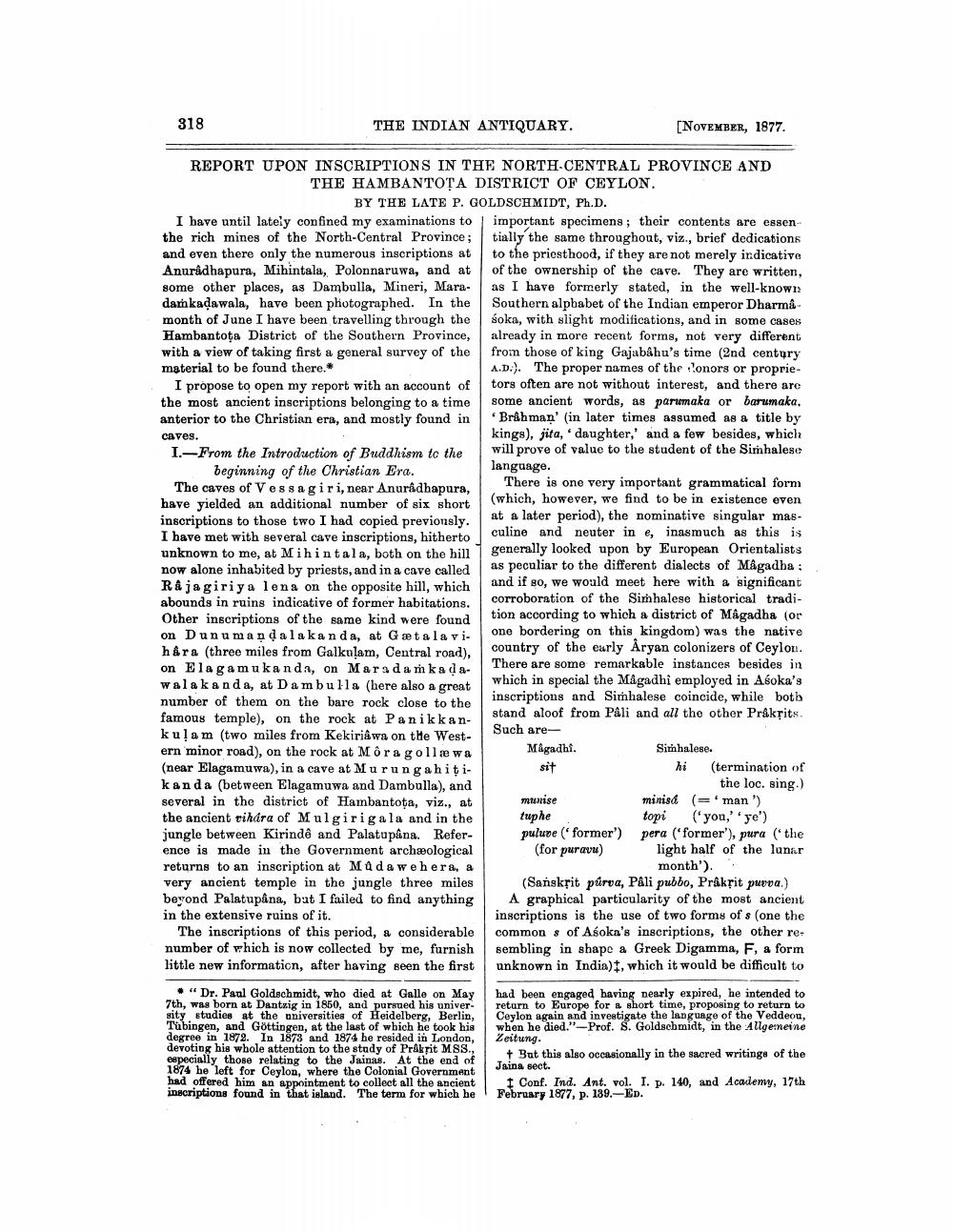________________
318
THE INDIAN ANTIQUARY.
[NOVEMBER, 1877
REPORT UPON INSCRIPTIONS IN THE NORTH.CENTRAL PROVINCE AND
THE HAMBANTOTA DISTRICT OF CEYLON.
BY THE LATE P. GOLDSCHMIDT, Ph.D. I have until lately confined my examinations to important specimens; their contents are essenthe rich mines of the North-Central Province; tially the same throughout, viz., brief dedications and even there only the numerous inscriptions at to the priesthood, if they are not merely indicative Anuradhapura, Mihintala, Polonnaruwa, and at of the ownership of the cave. They are written, some other places, as Dambulla, Mineri, Mara- as I have formerly stated, in the well-known dam kadawala, have been photographed. In the Southern alphabet of the Indian emperor Dharma month of June I have been travelling through the śoka, with slight modifications, and in some cases Hambantota District of the Southern Province, already in more recent forms, not very different with a view of taking first a general survey of the from those of king Gajabahu's time (2nd century material to be found there.*
A.D.). The proper names of the lonors or proprieI propose to open my report with an account of tors often are not without interest, and there are the most ancient inscriptions belonging to a time some ancient words, as parumaka or barumaka, anterior to the Christian era, and mostly found in Brahman' (in later times assumed as a title by caves.
kings), jita, daughter,' and a few besides, which I.-From the Introduction of Buddhism to the will prove of value to the student of the Sinhalese beginning of the Christian Era.
language. The caves of Vessagiri, near Anuradhapura,
There is one very important grammatical form have yielded an additional number of six short
(which, however, we find to be in existence even inscriptions to those two I had copied previously.
at a later period), the nominative singular masI have met with several cave inscriptions, hitherto
culine and neuter in e, inasmuch as this is unknown to me, at Mihintala, both on the hill
generally looked upon by European Orientalists now alone inhabited by priests, and in a cave called
as peculiar to the different dialects of Magadha : Rajagiriya lena on the opposite hill, which
and if so, we would meet here with a significant abounds in ruins indicative of former habitations.
corroboration of the Simhalese historical tradiOther inscriptions of the same kind were found
tion according to which a district of Magadha (or on Dunuman dalakanda, at Gætala vi
one bordering on this kingdom) was the native hara (three miles from Galkulam, Central road),
country of the early Aryan colonizers of Ceylon. on Elagamu kanda, on Mars da m kada
There are some remarkable instances besides in walakanda, at Dambulla (bere also a great
which in special the Mågadhi employed in Asoka's number of them on the bare rock close to the
inscriptions and Simhalese coincide, while both famous temple), on the rock at Panikkan
stand aloof from Pali and all the other Prakrits. kulam (two miles from Kekiriâ wa on the West
Such are ern minor road), on the rock at Mô ra golle wa
Mågadhi.
Sinhalese. (near Elagamuwa), in a cave at Murungahiti
sit
hi (termination of kanda (between Elagamuwa and Dambulla), and
the loc. sing.) several in the district of Hambantota, viz., at munise
minisa (='man") the ancient rihara of Mulgirigala and in the tuphe
topi (you,''ye') jungle between Kirindê and Palatupâna. Refer- puluve former) pera (former"), pura (the ence is made in the Government archæological (for puravu) light half of the lanar returns to an inscription at Muda wehera, a
month'). very ancient temple in the jungle three miles (Sanskrit púrva, Pâli pubbo, Prakrit puvva.) beyond Palatupâna, bat I failed to find anything A graphical particularity of the most ancient in the extensive ruins of it.
inscriptions is the use of two forms of s (one the The inscriptions of this period, a considerable common 8 of Asoka's inscriptions, the other re. number of which is now collected by me, furnish sembling in shape a Greek Digamma, F, a form little new information, after having seen the first unknown in India) I, which it would be difficult to
"Dr. Paul Goldschmidt, who died at Galle on May 7th, was born at Dantuig in 1850, and pursued his university studies at the universities of Heidelberg, Berlin, Tubingen, and Göttingen, at the last of which he took his degree in 1872. In 1873 and 1874 he resided in London, devoting his whole attention to the study of Prikrit MSS. especially those relating to the Jainas. At the end of 1874 he left for Ceylon, where the Colonial Government had offered him an appointment to collect all the ancient inscriptions found in that island. The term for which he
had been engaged having nearly expired, he intended to return to Europe for a short time, proposing to return to Ceylon again and investigate the language of the Veddeon, when he died."-Prof. S. Goldschmidt, in the Allgemeine Zeitung.
+ But this also occasionally in the sacred writings of the Jaina sect.
I Conf. Ind. Ant. vol. I. p. 140, and Academy, 17th February 1877, p. 139.-ED.




